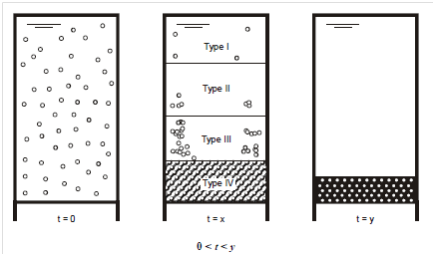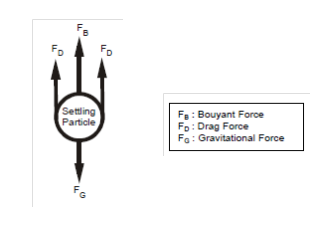Sedimentation
Sedimentation, a fundamental and widely used unit operation in wastewater treatment, involves the gravitational settling of heavy particles suspended in a mixture. This process is used for the removal of grit, particulate matter in the primary settling basin, biological floc in the activated sludge settling basin, and chemical flow when the chemical coagulation process is used.
Four types of settling occur, depending on particle concentration: discrete, flocculent, and hindered and compression (Figure 5). It is common for more than one type of settling to occur during a sedimentation operation.
Types of Sedimentation
Type I : Discrete particles - no particle interaction.
Type II : Flocculating Free Particles - large floc particles "sweep" smaller particles (faster than Type I).
Type III : Hindered - limited by fluid flow through particle groups.
Type IV : Compression - particles physically interact, water must be squeezed out to compress particle group.

a) Sedimentation of Particles

b) Forces Acting on a Discrete Settling Particle
Figure 5: Sedimentation of Particles and Forces on a Discrete Settling Particle
The rate of change in the momentum of a settling particle can be written as
mp dvs/dt = FG -FB -FD
where, mp = Mass of particle (kg),
vs = Particle settling velocity (m/s),
FG = Gravitational force (N),
FB = Buoyant force (N), and
FD = Drag force (N).
For an ideal system, the terminal settling velocity is attained quickly and the acceleration term can be neglected. Thus, the force balance on a settling particle can be written as follows:
mp (dvs/dt) = 0 = FG - FB - FD
or FD = FG - FB